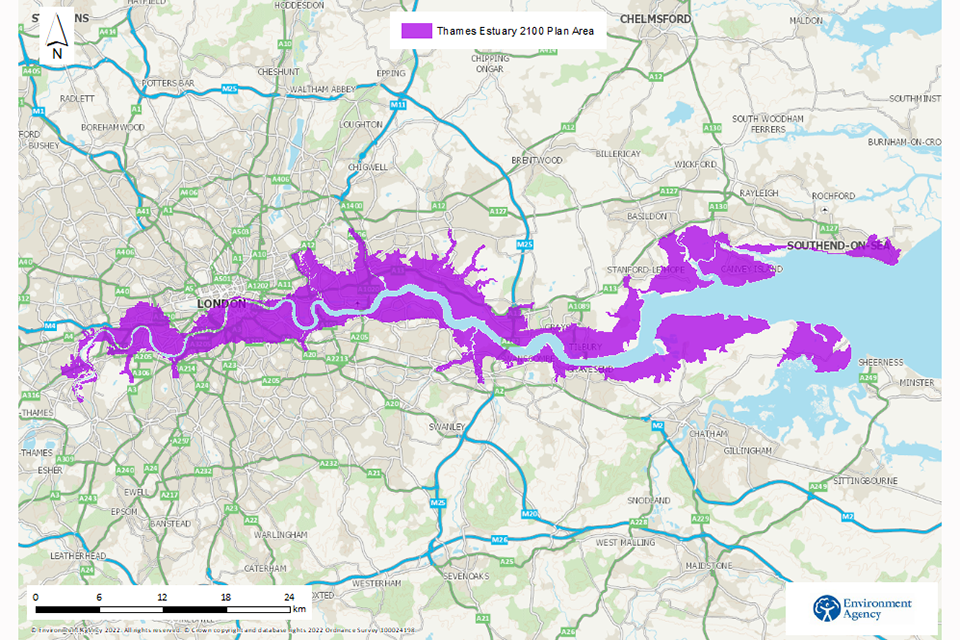Thames Estuary 2100: why we need it
The purpose of Thames Estuary 2100 (TE2100) and the challenges it aims to address.
Applies to England
The Thames Estuary needs action to adapt to climate change. Sea levels are rising. Tidal flooding from the River Thames is a real risk in future if we don’t act now. As summers get hotter, residents and workers will need more green space cooled by river breezes. Well-designed walking and cycling routes along the Thames could encourage sustainable transport, reducing carbon emissions and air pollution.
During the 21st century, tides will get higher because of:
- rising sea levels
- bigger, more frequent storms in the North Sea
More people, businesses and infrastructure will be at risk, because the population and number of buildings is growing all the time.
Tidal flood defences in the Thames Estuary
A world-class system of tidal flood defences protects people and buildings in the Thames Estuary. But these defences face big challenges.
Rising water levels
The defences were not built to withstand the higher water levels expected in the future.
In some places, sea levels will be high enough for waves to go over some defences and cause regular flooding by 2040. The Environment Agency, flood defence owners, landowners and councils need to improve the flood defence system to cope with these higher sea levels.
But there are some places where we must accept that flood risk will increase over time due to climate change. Communities and businesses need to be better prepared for flooding, and able to withstand it and recover quickly when it happens. We call this resilience. It will never be possible to prevent all flooding.

Map showing the extent of the Thames Estuary from Twickenham in the west to Southend-on-Sea and Sheerness in the east - a distance of around 80 kilometres (km). It marks the Thames Barrier at Woolwich. It also shows the extent of flooding in the estuary where there is a 0.1%, or higher, chance of flooding each year without flood defences. The map extends to Chelmsford, 28km to the north, and Sevenoaks, 24km to the south.
Ageing flood defences
Most of the tidal flood defences in the estuary were built many decades ago. They deteriorate over time, and many will come to the end of their useful life between 2030 and 2060. The Environment Agency and its partners are investing in repair and maintenance to make sure they can continue to protect us.
Environmental impacts
When the flood defences were built, environmental improvements and sustainability were not part of plans in the way they are today. The walls and embankments along the estuary protect the surrounding land from flooding. But, in some places, they:
- cut people off from the river
- contribute to low-quality public spaces
- provide little habitat for wildlife to thrive
The tidal defences need to be maintained and adapted to rising sea levels in a way that creates a better, more accessible riverside environment.
Doing this on the scale of the whole estuary will take major investment and long-term planning. This is a huge challenge. It requires a strategic approach and collaboration between many stakeholders.
The Thames Estuary 2100 Plan
To face these challenges the Environment Agency has worked with partners to create the Thames Estuary 2100 (TE2100) Plan. The first version of the Plan was published in 2012 and updated in 2023.
Find out more about major updates to the Thames Estuary 2100 Plan between 2012 and 2023
The Plan is a long-term strategic plan with 3 main aims.
Aim A
Take an adaptive approach to manage tidal flooding and create climate resilient communities.
Aim B
Protect and enhance the value of the Thames, its tidal tributaries and floodplain. Deliver social, cultural and commercial benefits for communities and support resilient growth.
Aim C
Tackle the climate and nature crises by putting sustainability at the heart of this Plan. Restore ecosystems, reduce carbon emissions, and deliver environmental and biodiversity net gain.
Find out more about the aims and objectives of Thames Estuary 2100
Before the Plan, flood risk management in the Thames Estuary consisted of raising the defences after a series of catastrophic floods. Taking an adaptive approach means looking ahead to future changes to the climate and in the estuary. Understanding how the estuary will change means that we can act now to be ready for the future.
The need to improve the tidal defences creates opportunities to rebuild the riverside. We can create a life-enhancing environment for the people who live and work there. This will benefit local economies and the businesses that operate in the estuary. And it will create better habitats for wildlife to thrive.
We must do all this in a sustainable way, so that we can reduce the environmental impact and help tackle the climate crisis.
The Plan sets out what the Environment Agency and others need to do to achieve these aims for the whole tidal Thames. It stretches from Teddington in west London, through Central London and out to the North Sea between Shoeburyness in Essex and Sheerness in Kent.

Map showing the Thames Estuary 2100 area from Twickenham in the west to Southend-on-Sea and Sheerness in the east - a distance of around 80km. It includes all 23 policy units and also shows surrounding areas. The map extends to Chelmsford, 28km to the north, and Sevenoaks, 24km to the south.